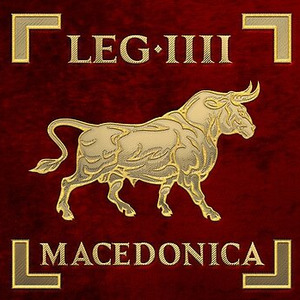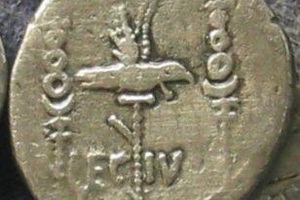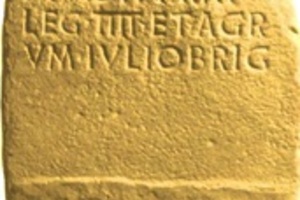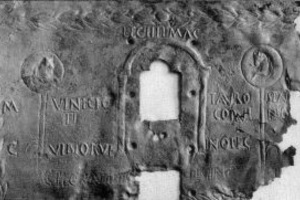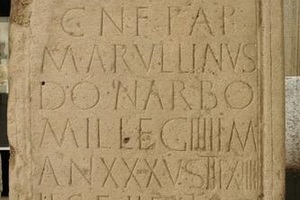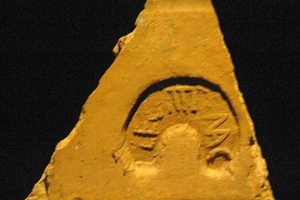Roman Legion - Legio IIII Macedonica
Legio IIII Macedonica (Fourth Macedonian Legion) was a Roman legion of the imperial era, created by Gaius Julius Caesar in 48 BC to fight against his former ally, Gnaeus Pompey the Great.
Dates of existence: 48 BC – 70 AD
Symbol: Bull and Capricorn, possibly a unicorn
Nicknames: Macedonica (Macedonian)
Battle Path
- Legio IV Macedonica was created by By Gaius Julius Caesar in 48 BC to fight against Gnaeus Pompey the Great.
- The legion had its baptism of fire at the Battle of Dyrrachium in 48 BC. Later, Legio IV Macedonica was transferred to Macedonia, hence its nickname "Macedonian."
- In the summer of 44 BC .Mark Antony recalled Legio IV Macedonica to Italy, where it fought for him, but later it came under the command of Octavian Augustus.
- Legio IV Macedonica participated in the Battle of Mutina in April 43 BC, suffering heavy losses.
- In the struggle between Caesar's assassins and his heirs, Legio IV Macedonica sided with the Caesarians.
- In 42 BC, it took part in the Battle of Philippi on the side of the Caesarians, later returning to Italy with Octavian Augustus.
- In Italy, during the winter of 41/40 BC, Legio IV Macedonica fought in the Perusine War against the brother of Mark Antony. Sling bullets testify to its presence during the siege of Perugia.
- In the war between Mark Antony and Octavian Augustus, Legio IV Macedonica sided with Octavian. On Octavian's side, Legio IV Macedonica participated in the naval Battle of Actium in 31 BC. After Octavian's victory, veterans of Legio IV Macedonica were settled in Veneto (modern Venice, Italy).
- Replenished, Legio IV Macedonica was stationed by Octavian Augustus in Tarraconensis (Hispania) after 30 BC. Here, Legio IV Macedonica participated in the Cantabrian Wars, which lasted from 25 to 13 BC. The legion was based in Herrera de Pisuerga (modern city in Spain).
- Veterans of Legio IV Macedonica were settled in a city named Cuartango (from quattuor, "four"), and another group of veterans, along with veterans from other legions, were settled in the city of Colonia Caesaraugusta (modern Zaragoza, Spain).
- After 13 BC, as Hispania became more peaceful, legionaries of Legio IV Macedonica engaged in construction work, as evidenced by inscriptions found.
- It is unknown under which Roman emperor, Caligula or Claudius, Legio IV Macedonica was transferred from Hispania to Mogontiacum (modern Mainz, Germany) in Upper Germany. It is known for certain that here it replaced Legio XIIII Gemina Martia Victrix, which was sent to invade Britain. Regardless, from 43 AD, Legio IV Macedonica was stationed in Germany.
- In Germany, Legio IV Macedonica shared its base with Legio XXII Primigenia. A vexillation of Legio IV Macedonica was stationed in Bingium (modern Bingen, Germany), confirmed by inscriptions found on stones at this site.
- It is assumed that Legio IV Macedonica participated in suppressing the revolt of the governor of Lugdunensis Gaul, Gaius Julius Vindex, in 68 AD.
- IIn the civil war that broke out after Emperor Nero's suicide in the summer of 68 AD, Legio IV Macedonica and Legio XXII Primigenia sided with Vitellius, governor of Lower Germany. A large vexillation of Legio IV Macedonica went with Vitellius to Rome, where it participated in two battles at Cremona (1st and 2nd Battles of Bedriacum). Several legionaries of Legio IV Macedonica were transferred to the Praetorians (imperial guard) for their military merits.
- In October 69 AD, during the 2nd Battle of Bedriacum against Vespasian's forces, the main forces of Legio IV Macedonica were defeated and abandoned their camp on the battlefield.
- At the same time, a large vexillation of Legio IV Macedonica led by its legate Aulus Caecina Alienus defeated the Germanic tribe of the Helvetii, securing the Po Valley for Rome.
- In the winter of 69/70 AD, in Lower Germany, a rebellion of the Batavian tribe against Roman authority erupted. Legio IV Macedonica, during the Batavian revolt, ensured the safety of Mogontiacum (modern Mainz, Germany) and fought against the Germanic tribes of the Chatti, Usipetes, and Mattiaci, who joined the Batavian revolt. At this time, Legio IV Macedonica was commanded by Quintus Petillius Cerialis. Despite the soldiers of Legio IV Macedonica not disgracing themselves by surrendering to the rebels, as other legions in Lower Germany did, and bravely fighting in the suppression of the Batavian revolt, Emperor Vespasian, remembering that Legio IV Macedonica sided with Vitellius, disbanded Legio IV Macedonica in 70 AD.
- From the former soldiers of Legio IV Macedonica, with additional recruits, Emperor Vespasian created Legio IIII Flavia Felix in 70 AD.
- Under Emperor Domitian, veterans of the former Legio IV Macedonica and several other legions were settled in the newly founded city of Scupi (modern Skopje, North Macedonia).
Related topics
List of Roman Legions, Legio IIII Flavia Felix, Legion, Legionnaire, Gaius Julius Caesar, Gnaeus Pompey the Great, Mark Antony, Octavian Augustus, Legio XXII Primigenia, The Praetorians
Literature
1. D. Baatz, "Catapult of Legion IV Macedonica at Cremona," in: Mitteilungen des deutschen archäologischen Institut Röm. Abt.) 87 (1980) 283-299
2. H. Gomez-Pantoja, "Legio IIII Macedonica," in: Yann Le Bohec, Les legions de Rome sous le Haut-Empire (2000, Lyon) 105–117
3. A. Morillo Serdan, "La legio IIII Macedonica en la península Ibérica. El campamento de Herrera de Pisuerga (Palencia)," in: Yann Le Bohec, Les legions de Rome sous le Haut-Empire (2000 Lyon) 609-624
4. R. Cania, "A Brief History of Various Legions."
5. Dando-Collins, "Legions of Rome. The Complete History of Every Roman Legion." M. Centerpolygraph Publishing. 2017.
6. M. Junkelmann, "Augustus' Legions."
7. Y. Le Bohec, "The Roman Army."
8. D. Campbell, B. Delf, "Greek and Roman Artillery 399 BC - 363 AD."
